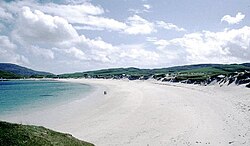Vatersay
| Vatersay Gaelic: Bhatarsaigh | |
 Vatersay Bay | |
|---|---|
| Main village: | Baile Bhatarsaigh |
| Location | |
| Location: | 56°55’48"N, 7°31’48"W |
| Grid reference: | NL635955 |
| Area: | 2,372 acres |
| Highest point: | Theiseabhal Mòr, 623 feet |
| Data | |
| Population: | 94 |
Vatersay is an inhabited island in the south of the Outer Hebrides, belonging to Inverness-shire. Vatersay is also the name of the only village on the island.
The name "Vatersay" is from the Norse for Water island.
Vatersay is westernmost permanently inhabited place in these most westerly isles. It is linked to Barra by a causeway completed in 1991. At low tide, the island is also linked to the islet of Uineasan to the east.
Wildlife
Wildlife on the island includes otters, seals and herons. Bonnie Prince Charlie's flower Calystegia soldanella is found only on Vatersay and Eriskay and romantic legend has it that it was brought here as French seeds dropped by Bonnie Prince Charlie at his arrival in 1745.
Archaeology
The island has remains of an Iron Age broch at Dun a' Chaolais overlooking the Sound of Vatersay and nearby is a passage grave dated to the 3rd millennium BC.[1] There is also a Bronze Age cemetery at Treasabhaig south of the heights of Theiseabhal Mòr[2] and a cairn built circa 1000 BC west of the village of Vatersay.[3]The offshore islet of Biruaslum has a walled fort that may be of Neolithic provenance.[4]
Wrecks

One of the saddest events to befall the island happened when the Annie Jane, a three-masted immigrant ship out of Liverpool bound for Montreal, struck rocks off West Beach during a storm in September 1853. Within ten minutes the ship began to founder and break up casting 450 people into the raging sea. In spite of the conditions, islanders tried to rescue the passengers and crew.[5]
There were only a few survivors rescued. A small cairn and monument marks the site. The inscription reads: "On 28th September 1853 the ship Annie Jane with emigrants from Liverpool to Quebec was totally wrecked in this bay and threefourths of the crew and passengers numbering about 350 men women and children were drowned and their bodies interred here."
Two Chinese seamen from the SS Idomeneus which sank on 28th September 1917 are also buried somewhere near the monument. There is a commemorative headstone in Cuier Churchyard. [6]
The remains of a Catalina flying boat that crashed on the slopes of Heishival Beg in 1948 lie in a stream bed near the shore.[7]
Outside links
- Panorama of the West Bay on Vatersay (Annie Jane burial cairn and monument) (QuickTime required)
References
- ↑ Branigan (2007) p. 65
- ↑ Branigan (2007) p. 66
- ↑ Branigan (2007) p. 68
- ↑ Branigan (2007) p. 67
- ↑ "Annie Jane Memorial - the story". Isle of Vatersay. http://www.isleofvatersay.com/Vatersay2chist.html. Retrieved 2008-11-06.
- ↑ CWGC Dept of Honour
- ↑ "Consolidated Catalina: Vatersay, Heishival Beg". Canmore. Retrieved 13 Nov 2011.
- Branigan, Keith (2007) Ancient Barra: exploring the Archaeology of the Outer Hebrides. Comhairle nan Eilean Siar.